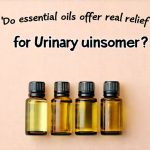Perineal inflammation, often experienced as discomfort, pain, or irritation in the area between the anus and vagina (or scrotum in males), can significantly impact quality of life. It’s a common issue arising from various causes – childbirth, episiotomy healing, hemorrhoids, friction from activities like cycling, even certain skin conditions. While conventional treatments exist, many individuals are exploring gentle, natural approaches to soothe irritation and promote healing. Herbal oils, carefully crafted with specific botanical properties, offer a compelling avenue for supportive care. This article will delve into the potential benefits of homemade herbal oil blends for perineal discomfort, focusing on safe practices and appropriate choices, always emphasizing that these are complementary therapies and should not replace professional medical advice.
The beauty of creating your own herbal oils lies in customization and control over ingredients. You know exactly what’s going into the blend, avoiding potentially irritating synthetic additives found in some commercial products. More importantly, you can tailor the oil to address your specific needs and sensitivities. A blend designed for postpartum healing will differ from one geared towards soothing friction-induced irritation. However, it’s crucial to approach this with respect and knowledge; not all oils are created equal, and certain herbs should be avoided or used cautiously in sensitive areas. Proper preparation and dilution are paramount to prevent adverse reactions.
Understanding Perineal Inflammation & Herbal Support
Perineal inflammation isn’t a single condition but rather a symptom manifesting from various underlying causes. Identifying the root issue is vital for effective management, and consultation with a healthcare professional is always recommended. Common contributors include:
– Postpartum recovery (especially after episiotomy or tearing)
– Hemorrhoids & anal fissures
– Skin sensitivities and allergies (contact dermatitis)
– Friction from activities like cycling or prolonged sitting
– Infections (yeast, bacterial vaginosis – require medical attention!)
Herbal oils can offer supportive relief by addressing inflammation, promoting healing, reducing discomfort, and providing a protective barrier. The key is selecting herbs known for their gentle yet effective properties. Calendula, chamomile, lavender, and St. John’s Wort (used cautiously – see below) are frequent choices due to their anti-inflammatory, soothing, and wound-healing abilities. It’s important to remember that herbal oils support healing; they don’t replace necessary medical interventions like antibiotics or pain medication when indicated. If you’re also experiencing urinary discomfort alongside perineal inflammation, exploring herbal oils for urinary comfort might be beneficial.
The effectiveness of herbal oils stems from the complex chemical constituents within each plant. Calendula, for example, contains compounds that promote tissue regeneration and reduce inflammation. Lavender offers calming and antiseptic properties while chamomile soothes irritated skin. However, dilution is absolutely essential. Never apply undiluted essential oils directly to the perineal area or any sensitive skin. Carrier oils like sweet almond oil, jojoba oil, or fractionated coconut oil act as a base for dilution and also contribute their own beneficial properties – moisturizing, nourishing, and enhancing absorption of herbal compounds. Choosing high-quality carrier and infused herbs is vital for optimal results.
Creating Your Herbal Oil Blend: A Step-by-Step Guide
Making your own herbal oils isn’t difficult but requires patience and attention to detail. There are two primary methods: infusion (slow method) and essential oil blending (faster, requiring greater caution). Infusion involves steeping herbs in a carrier oil over time, allowing their properties to be extracted. Essential oil blending utilizes pre-made essential oils diluted into a carrier oil. For perineal inflammation, infused oils are generally preferred due to their gentler nature. Here’s a basic infusion process:
1. Choose your herbs: Calendula flowers, chamomile blossoms, lavender buds are excellent choices. Dried herbs are preferable for longevity and reduced water content.
2. Select your carrier oil: Sweet almond oil, jojoba oil, or fractionated coconut oil work well. Organic, cold-pressed oils are ideal.
3. Combine herbs & oil: Place approximately ¼ cup of dried herbs into a clean glass jar. Pour in enough carrier oil to completely cover the herbs (about 1 cup).
4. Infuse the oil: There are two methods – slow infusion and warm infusion. Slow infusion involves sealing the jar and placing it in a cool, dark place for 4-6 weeks. Warm infusion involves gently heating the oil/herb mixture over low heat for 2-3 hours (avoid overheating!).
5. Strain & store: After infusion, strain the oil through cheesecloth or a fine mesh sieve to remove the herbs. Store in a clean, airtight glass bottle away from light and heat.
Essential oil blending requires even more caution. If using essential oils always dilute them properly – generally 1-3% dilution for sensitive areas. This means adding only 1-3 drops of essential oil per tablespoon of carrier oil. Common choices include lavender, chamomile (Roman or German), and tea tree oil (use sparingly and with caution). Always perform a patch test before applying any new blend to the perineal area. Never use undiluted essential oils. Remember that some essential oils are contraindicated during pregnancy or breastfeeding – always consult with a healthcare professional.
Choosing the Right Herbs for Your Needs
The selection of herbs should be based on your specific symptoms and sensitivities. For postpartum healing, calendula is a star player, promoting tissue regeneration and reducing inflammation. Comfrey (used externally only!) can also aid in wound healing but has potential risks with internal use – avoid it entirely if you are unsure. Chamomile adds soothing qualities while lavender offers antiseptic properties. If dealing with hemorrhoid discomfort, witch hazel (in an oil infusion) can provide cooling relief, though some individuals may find it drying. Plantain leaf is another excellent option for reducing inflammation and promoting healing in this area. Avoid using herbs that are known irritants or allergens – always listen to your body. For broader support of urinary health alongside these remedies, consider beneficial plant oils for the urinary system.
Consider the type of inflammation you’re experiencing. Is it primarily a burning sensation? Soothing herbs like chamomile and lavender may be beneficial. Is it characterized by redness and swelling? Calendula and plantain can help reduce inflammation. If there’s itching, ensure the blend isn’t overly drying – jojoba oil is excellent for maintaining moisture balance. It is crucial to avoid using herbs known to cause photosensitivity if you will be exposed to sunlight after application. Some herbs also interact with medications; consult your healthcare provider before incorporating herbal remedies into your routine.
Safety Precautions & Potential Contraindications
Safety should always be the top priority when creating and using homemade herbal oils. Always perform a patch test on a small area of skin (e.g., inner arm) to check for any allergic reactions or sensitivities before applying to the perineal area. If you experience any irritation, discontinue use immediately. Avoid using essential oils if pregnant or breastfeeding without consulting your healthcare provider. Certain herbs are contraindicated in specific medical conditions – for example, St. John’s Wort can interact with antidepressants and should be used cautiously.
Be mindful of potential allergens. Some individuals may be sensitive to plants in the Asteraceae family (e.g., chamomile, calendula), so start with a small amount and monitor for any reactions. Ensure your herbal oils are stored properly – away from light, heat, and moisture – to prevent rancidity. Never use oil blends on open wounds or infected areas without first consulting a healthcare professional. Remember that these remedies are complementary therapies and should not replace conventional medical treatment when necessary. Further reducing discomfort can be achieved by exploring natural oils to reduce urethral irritation if that is part of your symptoms.
Application & Ongoing Care
Applying the herbal oil blend is straightforward but requires gentle care. Ensure the perineal area is clean and dry before application. Use your fingertips to gently apply a small amount of oil, avoiding vigorous rubbing. A little goes a long way! You can use the oil 1-3 times daily as needed. For postpartum healing, applying after each bathroom visit can help keep the area clean and moisturized. Consistency is key – regular application supports ongoing healing and reduces discomfort.
Combine herbal oil therapy with other supportive measures for optimal results. This includes maintaining good hygiene, wearing breathable cotton underwear, avoiding harsh soaps or detergents, and practicing sitz baths (warm water soaks) to soothe inflammation. If symptoms persist or worsen, seek medical attention promptly. Remember that herbal oils are a gentle approach to support healing; they are not a cure-all. Prioritize your overall well-being and listen to your body’s signals. A holistic approach – combining natural remedies with conventional care when needed – is often the most effective path to restoring comfort and health. To support this, consider incorporating comfortable clothing choices for reduced pressure.





















